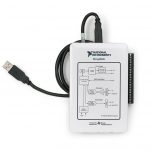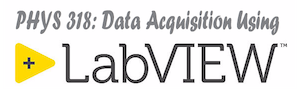The PHYS 318 calendar will link to pages similar to this for each class meeting during the semester. It is important that you consume the content in the red boxes prior to coming to class each day. This content will consist of some material from other areas of this web site and some material from NI’s online training modules.
These daily pages are set up to where links to the content will open in a new tab. After finishing that material you can simply close the tab and return to the daily content page to progress through rest of the pre-class material. Material in the grey boxes will be discussed during class.
 Each student in the course is required to obtain a myDAQ data acquisition system to use for assignments and projects. Please purchase your myDAQ right away and bring it to class every day. The myDAQ has two analog input channels for measuring from sensors, two analog output channels for controlling actuators, as well as digital I/O and counters. It connects to a computer via a USB cable so you can use it with your own computer or with a university-owned computer that has LabVIEW installed.
Each student in the course is required to obtain a myDAQ data acquisition system to use for assignments and projects. Please purchase your myDAQ right away and bring it to class every day. The myDAQ has two analog input channels for measuring from sensors, two analog output channels for controlling actuators, as well as digital I/O and counters. It connects to a computer via a USB cable so you can use it with your own computer or with a university-owned computer that has LabVIEW installed.
You can purchase a new myDAQ from studica.com or obtain a used one from a previous PHYS 318 student. Be sure to order or obtain your myDAQ early so that you have it before the first day of class.
In order to get off to a good start in this course it is recommended that you spend some time before the semester begins to install LabVIEW and other support software that you will need onto your laptop computer. The following links describe in detail how to download and install LabVIEW and the data acquisition drivers required to allow it to interface with DAQ hardware and to configure LabVIEW’s settings to use recommended best practices. Please attempt to install and configure the software by following these instructions or emailing Professor Harper if you have questions.
LabVIEW
TortoiseSVN
We will use a source-code control system called subversion (SVN) and will use a client called TortoiseSVN to interface with subversion. We will learn much more about SVN soon but for now you should install TortoiseSVN onto your computer and configure it as described in the links below.
Add-Ons
Finally, the following links describe how to install some third-party add-ons that greatly extend the capabilities of LabVIEW. To install these add-ons you will use a tool called the VI Package Manager which was installed along with LabVIEW earlier.
The syllabus describes the course policies, required materials, and the overall expectations for the course. The grading rubric describes how all programming assignments will be graded. We will review both of these documents, which are always easily available via the Course Info main menu item on our web site, on the first day of class.
The following links provide a brief introduction to LabVIEW. You will learn about Virtual Instruments, front panels, block diagrams, controls, and indicators, write a simple program that finds the sum and difference of two numbers, and then download and run an intermediate program (as a VI Snippet) that graphs an oscillatory signal.
We will distribute a breadboard that will connect to your myDAQ and a box of wires and other components. These items are loaned to you for the semester and should be returned when the semester is complete.
Here you will get a brief overview of the capabilities of your myDAQ device. You will see how to use the myDAQ as a digital multimeter and will get a tour of the inputs and outputs of the device.
We will use TortoiseSVN to interface with a Subversion (SVN) source-code-control repository on the physics.wku.edu server. The address of our repository is:
svn://physics.wku.edu/phys318/
There is a bit of a learning curve to SVN but once you get the hang of it you will appreciate the benefits it provides. The following links give an introduction to using SVN and advice on how to initially set up some working directories for use in this course.
NI provides a large number of self-paced online training courses to support their software and hardware. The content in WKU PHYS 318 will be structured around three of these courses: LabVIEW Core 1, LabVIEW Core 2, and Data Acquisition Using NI-DAQmx and LabVIEW. Selected modules from each of these courses will be identified on our calendar for for you to view and study before each class.
You will have free access to these courses via your LabVIEW Student License that you should have associated with your NI account during the software installation process. The following video describes how to consume this online training material. Watch this video and then attempt to view the first four (all short) lessons which give an overview of LabVIEW and data acquisition.
You should consume the first four modules, all of which are short, from LabVIEW Core 1 before our first class to give you a feeling for what LabVIEW can do. These modules kind of have a marketing flavor. We will get down to business of learning LabVIEW in subsequent modules.
Access LabVIEW Core 1 Course- 1. Welcome to LabVIEW
- 2. Introduction to LabVIEW
- 3. First Measurement (NI DAQ Device)
- 4. First Measurement (Non NI Instrument)



